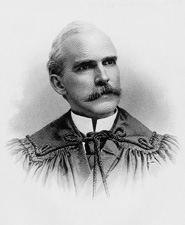
Joseph Haynsworth Earle was a United States Senator from South Carolina.
Elias Earle was a United States Representative from South Carolina. Born in Frederick County in the Colony of Virginia, he attended private school and moved to Greenville County, South Carolina, in September 1787. He was one of the earliest ironmasters of the South, and prospected and negotiated in the iron region of Georgia.
Earle House may refer to:

Old Pickens Jail, also known as Pickens County Jail, is a historic jail located at Pickens, Pickens County, South Carolina. It was built in 1903, and is a two-story, brick building with a two-story crenellated tower. It was expanded in 1928 to provide additional space for the cellblock. The jail closed in August 1975, and has since been used as a historical museum and art gallery.

Earle Town House is a historic house in Greenville, South Carolina. It was listed in the National Register of Historic Places on August 5, 1969, and is included in the Col. Elias Earle Historic District.

Whitehall is a historic home located at Greenville, South Carolina. It was built in 1813 as a summer residence by Charlestonian Henry Middleton on land purchased from Elias Earle. Whitehall served as Middleton's summer home until 1820. It is a simple white frame structure with shuttered windows and wide first and second story galleries, or piazzas, in the Barbadian style.

Josiah Kilgore House, now known as the Kilgore-Lewis House, is a historic home located at Greenville, South Carolina. It was built about 1838, and is a two-story, L-shaped, vernacular Palladian style dwelling on a low foundation. It features a pedimented portico supported by square posts. It has a projecting rear wing with a three-bay porch. The structure was moved to a five-acre site in McPherson Park to prevent its demolition.
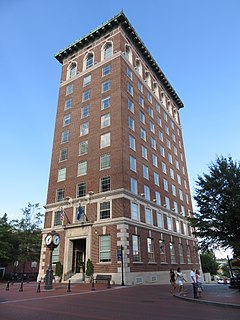
Chamber of Commerce Building, also known as the North Greenville College Building, is a historic office building located at Greenville, South Carolina. It was built in 1925, and is a ten-story rectangular brick sheathed steel frame building. The Chicago School style skyscraper consists of a two-story base with Neoclassical detailing, a seven-story shaft, and a roof story that features tall arched windows and a brick and stone frieze with transoms and stone panels.

Working Benevolent Temple and Professional Building is a historic office building located at Greenville, South Carolina. It was built in 1922, and is a three-story, steel frame brick building. The building housed offices for African-American doctors, lawyers, dentists, a newspaper, and insurance firms and housed the first black mortuary in Greenville. The temple was also the center for Greenville's civil rights activities during the 1960s.

Greenville County Courthouse, also known as Greenville Family Courts Building, is a historic courthouse located at Greenville, South Carolina. It was built in 1918, and is a Beaux-Arts style brick and concrete building with terra cotta trim. The building consists of a three-story front section, with an eight-story tower behind. The building served as the courthouse for Greenville County until 1950 when the court was moved to a new building. The Family Court of Greenville County was located then in the building and remained there until 1991.
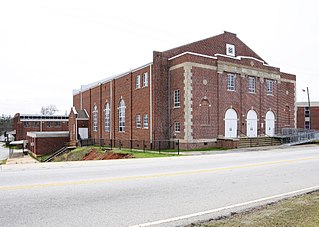
Parker High School Auditorium is a historic high school auditorium located at Greenville, South Carolina. It was built in 1938 with funding provided by the Works Progress Administration. It is a Classical Revival style 7500 square foot rectangular brick building with a front gabled roof. It is the last remaining building from the largest WPA school project in South Carolina.
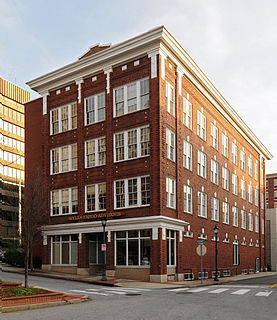
Carolina Supply Company is a historic commercial building located at Greenville, South Carolina. It was built in 1914, and is a four-story, brick building in a utilitarian Renaissance Revival style. The building housed a textile and industrial supply company that supplied mills with equipment and supplies. The building now houses Wells Fargo Bank.

Gilfillin and Houston Building also known as Greenville Bakery and Greenville Auto Sales, is a historic commercial building located at Greenville, South Carolina. It was built in 1915, and is a two-story, brick commercial block. The building's façade is organized into two storefront sections and features a curvilinear brick gable and parapet embellished with a central, circular, limestone-keyed and brick-surrounded cartouche containing the letters "G" and "H" intertwined.

Brushy Creek, also known as Vardry McBee House and Alexander McBee House, is a historic home located at Greenville, South Carolina. It was built about 1836 as a 1 1/2-story, frame farmhouse. In 1924, the house was expanded with the addition of a one-story frame room, that incorporated the formerly separate kitchen into the house itself. Further renovations were made in 1938–1939 and 1951. Also on the property are a log barn, a brick shed, a well house, and the ruins of a grist mill. It was the home of Vardry McBee (1775–1864), prominent 19th-century businessman, entrepreneur, and delegate to the Secession Convention of Greenville District known as the “Father of Greenville,” and his son Alexander McBee (1822–1897), prominent 19th-century businessman, banker, and state representative of Greenville District.

Richland Cemetery is a historic African-American cemetery located at Greenville, South Carolina. It was established in 1884 by the City of Greenville as the first municipal "colored" cemetery. It is the final resting place for many of Greenville's most notable African-American educators, health practitioners, and community leaders. The total number of graves is estimated at over 1,400 and gravemarker types and materials range from natural stones to elaborate Victorian monuments.

Hampton–Pinckney Historic District is a national historic district located at Greenville, South Carolina. It encompasses 70 contributing buildings in a residential section of Greenville. The houses date from about 1890 to 1930, and include Italianate, Greek Revival, Queen Anne, various bungalows, and examples of Gothic Revival and Colonial Revival design, as well as vernacular forms. The oldest house in the district is the McBee House.

West End Commercial Historic District is a national historic district located at Greenville, South Carolina. It encompasses 15 contributing buildings in Greenville's second "downtown." The commercial buildings primarily date from about 1880 to 1920, and include examples of Victorian commercial architecture. Notable buildings include the American Bank, Alliance and Mills & McBayer Cotton Warehouses, Indian River Fruit Store, Pete's Place, Bacot's West End Drug Store/Stringer's Drug, Furman Lunch, and Greer Thompson Building.
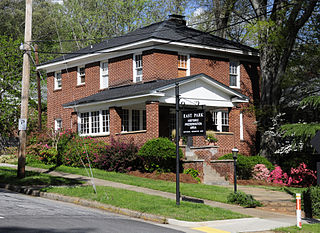
East Park Historic District is a national historic district located at Greenville, South Carolina. It encompasses 121 contributing buildings, 1 contributing site, and 3 contributing structures in a middle- / upper-class neighborhood of Greenville. The houses date from about 1908 to 1950, and include Neoclassical, Colonial Revival, Tudor Revival, Victorian, American Foursquare, Prairie Style, and bungalow styles.

Secessionville Historic District is a national historic district located near Folly Beach, Charleston County, South Carolina. It extends into the city of Charleston, South Carolina. The district encompasses six contributing buildings, one contributing site, and one contributing site in Secessionville. The district includes the summer homes of several leading James Island planters, the site of the American Civil War Battle of Secessionville, the unmarked grave of over 300 Union soldiers, and the remains of Fort Lamar, constructed about 1862.

Historic Cleveland County Courthouse is a courthouse building located at Shelby, Cleveland County, North Carolina.






















